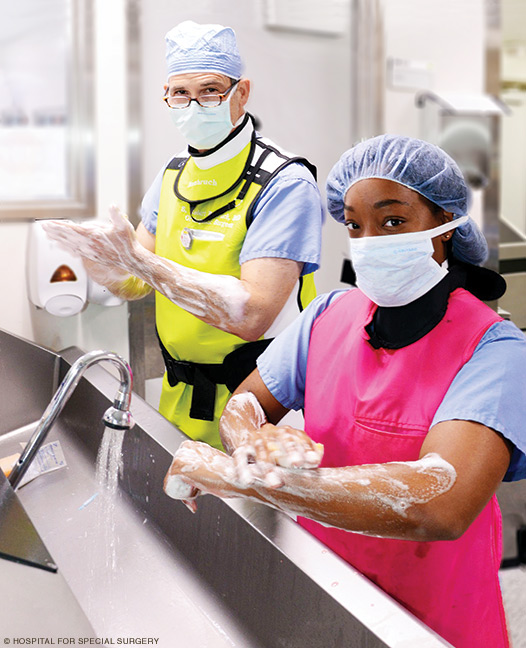
Why one precocious patient has followed the same path as her orthopedic surgeon.
Before being rolled into the operating room for the first of 17 surgeries, Amber Hamilton C’16 made an unusual request. The 12-year-old asked her surgeon, S. Robert Rozbruch C’85, if she could stay awake for as long as possible to look at the tools that would be used to fix her limb deformity.
“I remember him being shocked, but he also understood that I was interested,” says Hamilton, who thought of herself as an “abnormal kid” not because of her condition but because of the fascination she typically felt at the hospital. “Amber was always very positive and very inquisitive,” recalls Rozbruch. “I saw that at a young age—and I’ve continued to see that in the person she’s become.”
Born with a rare bone disorder called X-linked hypophosphatemia, which caused her to become severely bowlegged, Hamilton was referred to Rozbruch—chief of limb lengthening and complex reconstruction service at New York’s Hospital for Special Surgery (HSS)—almost 15 years ago. Since then, their relationship has morphed into one in which “I was mentoring her on life,” Rozbruch says.
Captivated by the procedures used to straighten her legs, and galvanized by her surgeon’s mentorship, Hamilton decided to follow the same path as Rozbruch. She was pre-med at Penn, currently attends Cornell’s medical school, and has already worked alongside Rozbruch on multiple occasions. “I kind of think of him as my work dad,” Hamilton says. “I’ve known him for so long.”
Hamilton has vivid memories of their first meeting. She had been living with her bowlegged deformity since an endocrinologist diagnosed her at 2, taking calcium and Vitamin D supplements about five times a day to control the condition. She was able to play basketball and do other activities, but she still felt insecure about it. “There was definitely an element of isolation,” she says. It wasn’t until sitting down with Rozbruch, when she was 11, that she realized, Wow, someone is actually going to fix my problem.
Rozbruch likens Hamilton’s condition to rickets, a bone disorder which in “olden times people developed for nutritional reasons.” Nutritional rickets has all but vanished in this country, but Hamilton is missing some of the enzymes to process Vitamin D, which depresses levels of phosphate—a mineral essential for normal bone formation—in her blood.
Since X-linked hypophosphatemia is not curable by Vitamin D supplementation, Rozbruch surgically attached stabilizing metal frames called external fixators to the bones on her legs. For several months, Hamilton turned the struts on the fixators to straighten and lengthen her thigh and shin bones a little bit at a time. Perhaps just as exciting for her, she got to examine the X-rays during follow-up appointments to see how the bones grew. “I just thought it was the coolest thing ever,” she says.
Like her bones, her interest continued to grow over the next 10 years, as she had 16 more surgeries. In the last, Rozbruch used a newer technique: implanting a lengthening rod with a small magnet into her thigh bone, with no need for an external fixator.
Today both of her legs are perfectly straight and of equal length. Now she hopes to help other kids get their legs and lives straightened, too. But even though orthopedics has intrigued her since she was young, she didn’t always see it as a career path. During her first semester at Penn, she even began to question if she wanted to go into medicine at all. It wasn’t until she got the opportunity to shadow Rozbruch after her freshman year that she had what she calls her “official I want to do orthopedics moment.”
“Just letting me wear that white coat, it was really moving for me,” she says. “It really revved me up and gave me the momentum needed to go into my sophomore year and kick pre-med’s butt.”
After graduating from Penn, the New York City native returned home to attend Cornell and then work at HSS this past summer. There she helped lead a study on the psychosocial needs of adolescents undergoing orthopedic surgery. “It’s really interesting to be on the opposite side now,” Hamilton says. She hopes the data—some of which shows, unsurprisingly to her, that “that age group really values independence”—will be published and perhaps modify the “core principles orthopedic surgeons should abide by when treating adolescents.”
She’s continued to work on the study since the summer research fellowship program ended, and Rozbruch believes Hamilton might return to HSS for residency after graduating from Cornell. “Then it’s possible she’ll do a fellowship in this field,” he says. “And who knows? Maybe she’ll even be my partner sometime in the future.”
That would be quite the end point for Hamilton, who’s developed a strong and oftentimes playful rapport with the surgeon who operated on her. “I always joke with him that I’ll know I’ve really made it the day I get to scratch his name off his door and put my name on it,” Hamilton says. “I’m trying to knock him out of his spot.”
After thinking about it a little more, she strikes a more conciliatory tone. “The goal is to work beside him. Maybe my name can be propped next to his.”
—DZ

